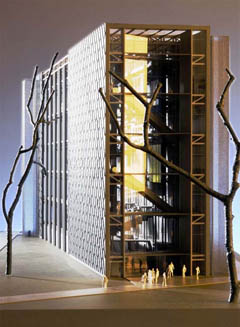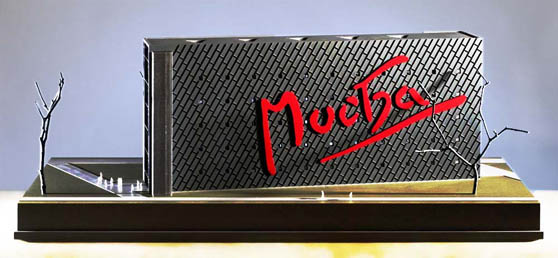
The city of Prague is at risk of losing the Mucha Epopee
 |
| Pavilion for the Slavic Epic (photo: www.czechartmodel.cz) |
The painter's heirs had reservations about the intention to exhibit the epic at the Exhibition Grounds in the seventh city district. They pointed out that the canvases would be in a place associated with fairs and carousels. According to Smetana, there is currently no dispute. "According to copyright law, the ownership is clear. A dispute may arise after 2010," Smetana stated.
According to councilor Milan Richter (ODS), legal opinions on this matter differ. It will only be resolved if the building is completed by 2010. It must also be in accordance with Mucha's will, who had a clear idea of the placement of the canvases, Richter told ČTK.
Smetana, together with Tomáš Kuklík, proposed a modern building with a steel structure for the Brussels route, which will look like a box turned on its side. The paintings should have an ideal microclimate in the building. "We do not want a gallery as such, but a publicly accessible technical depot," Smetana noted. He characterized the design as a pragmatic and ascetic building. The construction costs are estimated at 170 million crowns, of which 70 million would be needed for necessary technological facilities.
The authorities have already granted consent to the location of the object, and a building permit application is currently underway. According to the architect, the office now wants the approval of the municipal property management department, which reportedly communicated that it must be expressed by the tenant of the Exhibition Grounds, Incheba Praha. According to Smetana, the company unexpectedly stated at the end of the year that it does not agree with the construction of the pavilion. Richter mentioned that the representatives of Incheba find the proposed building disproportionately large in relation to the surroundings.
"It is a fundamental threat to the building permit," Smetana emphasized. If the building authority does not receive the opinion by the beginning of April, the proceedings will be halted, and a new application for the permit will have to be submitted. The deadline for completion by the end of 2010 would be jeopardized, the architect added.
He questioned Incheba's initiative, which, according to Smetana, proposed temporarily placing the canvases in one of the Křižík Pavilions. According to him, this would require a large investment considering the requirements of conservationists and conservators, and a building permit would be necessary. "It is a return to the beginning," the architect believes. He also pointed out that the pavilions are in a flood zone, whereas the new building would have the canvases one meter above the level of a thousand-year flood.
Richter stated that he came up with the idea of temporarily placing the epic in the Křižík Pavilions. He would like the canvases, which are currently in Moravský Krumlov in the Znojmo region, to be in the capital by the end of this year or the beginning of next year. The councilor is negotiating with Incheba about this, and the company agrees. However, it is necessary to verify the technical details, Richter added.
The epic has been at the castle in Moravský Krumlov, which is said to also belong to Incheba, for 45 years. There have been talks for many years about relocating the canvases depicting scenes from the history of the Slavs back to Prague. There have been many proposals for where the work should be exhibited, such as the Industrial Palace at the Exhibition Grounds and Klementinum. However, the painter's requirement would not be met, the city representatives argued. The plan for the construction of a new building was approved by the city council four years ago.
Relations between the city hall and Incheba Praha do not seem to be ideal. Councilors stated in December that the company did not invest the full 300 million crowns into the development of the area, as it was supposed to do by the end of last year. The modified study for the transformation of the Exhibition Grounds is also not completed. The city council agreed to extend the deadline for the preparation of the plan until mid this year.
However, the fact that Incheba did not invest the full 300 million into the exhibition grounds may also be attributed to the city. It did not purchase certain local plots from the company Pražská teplárenská as it had committed to do.
 |
| Pavilion for the Slavic Epic (photo: www.czechartmodel.cz) |
The English translation is powered by AI tool. Switch to Czech to view the original text source.
0 comments
add comment
Related articles
0
19.07.2021 | Visitors will see the Slavic Epic in M. Krumlov from the turn of July to August
0
24.06.2021 | Part of the epic arrived in Moravský Krumlov in the previous days, the rest is now on the way.
0
14.06.2021 | The Slavic Epic should be on display in Moravský Krumlov in July
0
25.01.2021 | Moravský Krumlov has approved spaces for the exhibition of the Epos
0
03.02.2011 | The relocation of the five canvases from the epic to Prague will begin on Monday
2
15.09.2010 | The Gallery of the Capital City of Prague will announce a new procedure for the installation of the epic
1
18.03.2009 | Praha had legal analyses prepared for the Epos
1
09.01.2009 | The leadership of Moravský Krumlov believes that the epic will remain in the city this year
4
13.11.2008 | Architect: The Křižík Pavilion does not correspond to the exhibition of the epic











